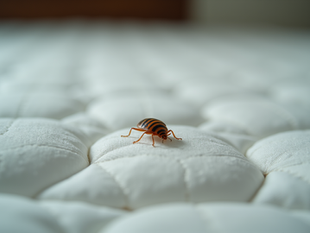
Uncovering the Truth: Do Bed Bugs Hibernate Differently in Summer and Winter?
2
20
1
Bed bugs are infamous for invading homes and causing distress. As seasonal changes occur, many people wonder how these pests adjust their behavior. Do bed bugs hibernate when it's cold, or are they active all year round? Understanding their lifecycle and environmental responses is critical to finding the answer.
Understanding Bed Bug Behavior
Bed bugs (Cimex lectularius) are small, nocturnal pests that primarily feed on the blood of humans and other warm-blooded animals. Known for their incredible ability to hide in tiny spaces, they are often hard to detect until an infestation occurs. A single female bed bug can lay up to 500 eggs in her lifetime, leading to rapid infestations if not controlled.
Unlike many insects that hibernate through harsh winters, bed bugs do not enter a true hibernation state. Instead, their activity is influenced primarily by temperature, significantly slowing down in colder conditions. For example, research indicates that bed bugs can survive temperatures as low as 46°F, but their reproductive and feeding activities diminish drastically in such conditions.
Bed Bug Lifecycle and Temperature Effects
Bed bugs undergo several stages in their lifecycle: egg, nymph, and adult. Each stage relies on a blood meal to develop and progress to the next. Their development is largely dependent on temperature; they thrive in warm environments, particularly between 70°F and 80°F. At temperatures below 50°F, their metabolism slows considerably, resulting in reduced activity.
In studies, bed bugs exposed to temperatures below 60°F showed a remarkable decrease in reproductive rates—down as much as 90% compared to warmer conditions. This means that while they can survive the cold, infestations may not grow as rapidly during winter.

Summer Activity: A Peak in Bed Bug Infestations
The summer months bring an increase in bed bug activity. Warmer temperatures and extended daylight hours create an ideal environment for breeding and feeding. Travel is also more frequent during this season, allowing bed bugs to spread easily as they hitch rides in luggage, clothes, and personal items.
Reports show that bed bug infestations often rise by as much as 50% during summer months. They tend to hide in bedding, furniture seams, and carpets, waiting for the night to come out and feed. As a result, being on high alert during summer travel becomes essential. Bed bug bites can lead to itchy welts and allergic reactions, making awareness and preventive measures even more crucial.
Winter Activity: More than Just Hibernate
As winter approaches, many mistakenly believe their homes are safe from bed bugs; however, these pests still pose a threat. Although bed bugs do not hibernate, their activity significantly decreases. They become harder to detect as they retreat to deeper hiding spots. Cold outdoor temperatures don't kill them; instead, they tend to be conservative with feeding.
Even in winter, if homes are heated, bed bugs can remain active. For instance, many homes in colder regions maintain indoor temperatures between 68°F and 72°F. This warmth allows bed bugs to become active even when the world outside is freezing. Homeowners may assume that winter conditions reduce their risk, but the truth is that bed bugs can thrive indoors year-round.
Prevention and Control Measures
To reduce the chances of bed bug infestations, it’s crucial to take proactive measures throughout the year. Here are effective strategies for prevention and control:
Regular Inspections: Check sleeping areas and common hiding places for signs of bed bugs, such as dark spots or shed skins.
Wash Bedding: Wash all bedding and clothing in hot water (at least 120°F) and dry on high heat regularly to eliminate any potential bugs or eggs.
Use Protective Covers: Invest in bed bug-proof encasements for mattresses and box springs to block access.
Be Cautious While Traveling: Inspect hotel rooms for any traces of bed bugs as soon as you arrive.
Call a Professional Exterminator: If you suspect an infestation, contacting a pest control professional is critical to addressing the problem promptly.
Staying Proactive Against Bed Bugs
In closing, bed bugs may not hibernate like some insects, but their behavior does shift with the seasons. They remain active year-round, adapting to environmental changes while finding deeper hiding spots during colder months. By understanding their lifecycle and seasonal patterns, homeowners can take the necessary steps to combat these unwanted guests.
Stay informed about bed bug behavior to act swiftly at the first signs of trouble. While summer invites peak activity, winter brings its own challenges. Armed with the right knowledge and preventive actions, anyone can effectively manage bed bug infestations. Whether enjoying summer days or cozy winter nights, being proactive will help maintain a pest-free home.







Very informative